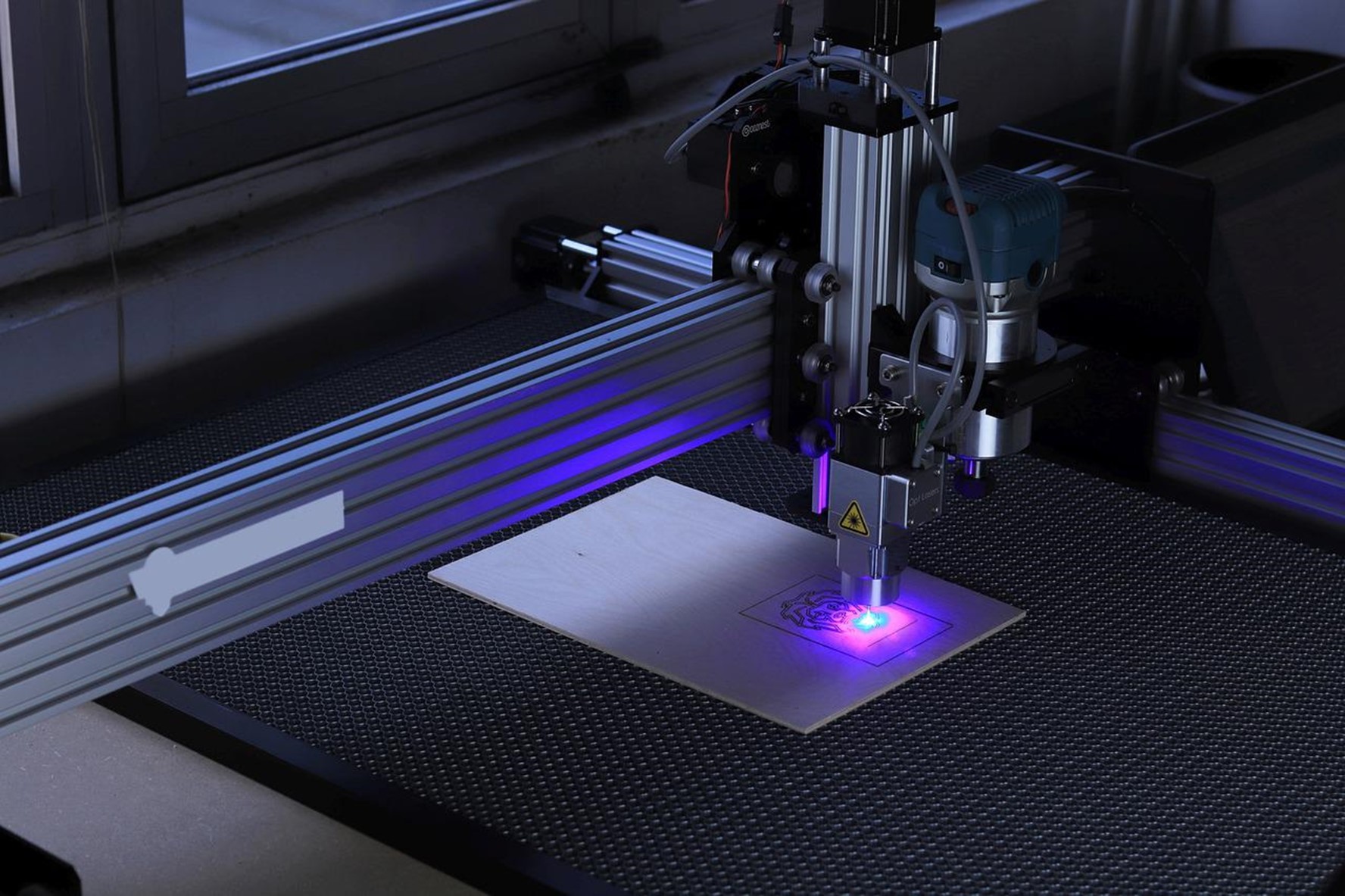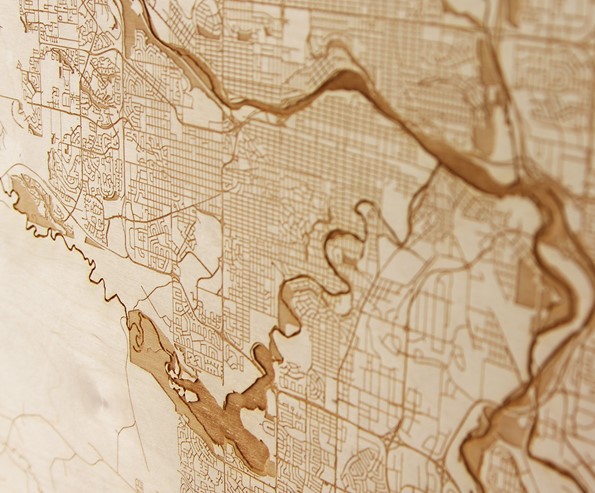Laser engraving is a simple and effective method for leaving permanent imprints on a variety of materials, including textiles, acrylics, wood, natural stones, metals, and more. A laser machine may be used to do everything from engrave company logos on products to creating personalised gifts. Most beginners like wood engraving because of its versatility and accessibility even though it can be a little challenging.

So, how do you etch wood using a laser? Laser wood engraving works similarly to laser engraving on other materials in that a laser beam is transmitted over the substance, heating it up and vaporising it. The outcome is a smooth, clear, and flawless engraving that no other woodworking machine can match.
The fundamental distinction between laser engraving on wood vs other materials is that the process creates sublimination of the wood. This means that the wood is instantly vapourised, transitioning from a solid state into a gas through the process of combustion which makes for a smoky workspace.
As wood is a natural material it is perfectly imperfect which while making each piece unique and beautiful, can also cause difficulty engraving. Understanding the best power and speed settings for different wood types will enable you to produce flawless inscriptions. It just takes a bit of experience.
Wood is very popular in the world of engraving because it is a versatile material. It's not only easy to cut and engrave, but it also comes in a wide range of colours, shapes, and sizes which makes it quite a quirky material to work with.
Warning: Wood is extremely combustible. To avoid accidents while wood engraving, you should therefore maintain a careful watch over the laser cutting process. A fire extinguisher should always be kept on hand just in case.
When laser engraving on wood, the type of wood you select will determine the wood engraving settings you’ll need to use. A bamboo cutting board, for example, will not engrave the same way an oak barrel will. Softwoods like redwood, western red cedar, southern pine, and balsa can be engraved without a lot of laser power.
They also work faster and produce lighter engravings. Hardwoods like thick wood, Brazilian ebony, snakewood, and African pearwood, on the other hand, require more laser power to cut through and engrave. These produce dark engravings as well. Finally, the sort of wood utilised has an impact on the final product.
Although most CO2 lasers can engrave all types of wood, there are a variety of alternative engravers that are better suited for certain types of wood. If you have an industrial laser engraver that can engrave on tougher materials like stone and metals, for example, laser engraving on wood will be a breeze.
When choosing the ideal wood for laser engraving, the resin content is just as crucial as the type of wood. Depending on the sap or resin content of the wood, it will burn lighter or darker. The laser beam vaporises woods with little resin content, leaving only a minor burn.
The laser beam will eat the resin and penetrate deeper into the wood if the resin level is high, resulting in a darker burn. If you're wondering which woods have the most resin, cherry and alder are always at the top of the list. Both are ideal for engraving jobs with light colours. Cherry, on the other hand, has a high amount of streaking but is still a good choice for wood engraving tasks.
As previously stated, the type of wood and its resin content are critical considerations for any laser cutting project. However, there are some other equally significant considerations to consider:
You can raise the defocus of the laser beam to get a darker engraving on wood. Not only will this reduce the laser's density performance, but it will also increase the spot size of the laser. As a result, more wood will be burned rather than passing through the beam in a gaseous state. Unfortunately, this brilliant method results in the loss of some engraved details.
You can alter your cutting settings to decide the cutting quality of your laser. To do so, draw a rectangle on a sheet of paper with two rounded corners as a test of what to expect. This should be sent to a laser. Start with a 2-5% cutting speed and a great performance for a 3mm thick wood. Reduce your cutting speed gradually until you achieve the desired quality.
When you use a wood laser on a hardwood material, a cloud of sticky dust forms on the etched object. This is not only inconvenient, but it can also cause your laser engraving machine to break down. To counteract this, use application tape to provide a temporary protective covering over the working surface. Simply remove it after you've finished engraving and clean your product. Application tape is great for broad surfaces but not for minor engravings or photoengraving. This is because, once the task is accomplished, you will have to remove hundreds of little bits.
As previously stated, wood engraving is a sublimation process. It's critical to select the right optics and focus them precisely. To achieve finer details, the rule of thumb is to use a lens with a shorter focal length. For most wood etching operations, a 1.5" to 2.0" lens will suffice. When cutting through wood, however, the thickness of the material comes into play. The longer the focal length of the lens utilised here, the thicker the wood.
It’s recommended that compressed air is used during the wood engraving process because of the amount of gas that is produced. The lens is protected by a tiny nozzle diameter, which directs pressurised air onto the cutting gap. This rapidly removes gas and dust, improving the laser's cutting quality.
Cleaning the laser hardware and optics is simple to overlook, yet it has a direct impact on the laser machine's functionality. Wood dust is high in oils and resins, making it extremely sticky. It won't be long before it settles on the equipment and causes it to malfunction. As a result, the laser engraver must be cleaned on a regular basis.
Streaking can easily occur in wood engravings. To avoid this, always use wood with minimum streaking and a clean, consistent grain when laser engraving it. There are nominal alternating dark and light stripes in woods with smooth and regular grain. When compared to wood with a high level of streaking, any engraving done on such wood varieties appears more detailed and clearer.
You can't do much about the natural colour of the wood, so to help your designs stand out and give your wood cutting a cleaner look stick to lighter wood, such as maple, or even a medium wood like walnut. When lighter wood is engraved, it acquires an appealing black burn that is ideal for maximum visibility.

A common question about wood engraving is how to laser cut plywood or MDF without scorching it. Engraving and cutting can both be done using laser engravers. The beam's power level is insufficient to burn the wood beyond what is required while engraving.
Cutting something thin like plywood, on the other hand, uses more power and produces more heat. Wood cutting might cause the surface to scorch leaving burns. This problem, fortunately, has a straightforward remedy.
A particularly built device or widget would appear to be the answer to a problem with a high-tech tool like a laser engraver. This is incorrect. Laser-cut plywood is protected from scorching with a simple coating of masking or transfer tape. Before cutting, apply transfer tape on plywood or MDF.
Is it because a thin layer of tape protects the wood from burn marks? Or is it used to lower the temperature of the laser? No. The laser's heat does not produce burn marks on wood or MDF. The interaction of the air near to the wood in the laser beam causes singing.
The burned appearance is caused by the air combusting immediately adjacent to the plywood surface. The tape prevents this by keeping the burning oxygen away from the wood surface. The cut edge of the wood will still discolour, but the surface will be unblemished and ready for your most picky consumers.
Cutting and engraving wood generate a lot of smoke, so you might wish to invest in a fume extractor to get rid of it. It's also a good idea to choose a system with a gas filter separate from the HEPA filter, because the gas filter will be used up before the HEPA filter.
Although practical, combining a HEPA filter and a gas filter in a single filter container would be inefficient and expensive in the long run because you would be compelled to throw away a perfectly good HEPA filter along with the wasted gas filter.
Laser wood engraving is an art form of its own and can be used in any woodworking project, from cabinetry to photo frames, knife handles, accessories and jewellery.
Laser engraving can be used to engrave amazingly intricate images on products and personalise inventory with a company's logo, brand or business name. The team at Krintech regularly receive requests from businesses to enhance their products and inventory, using wood engravings, particularly in the retail and hospitality sectors.
But wood engraving can also be used on a much more individual, personal level to produce one-of-a-kind, meaningful items. Adding a personal touch to instruments, skateboards, phone covers, photo frames, kitchen equipment or any other item can transform the ideal gift into a timeless keepsake.
What's more, laser technology is not limited to engraving. Laser machines boast a wide range of capabilities, including laser cutting, etching and inlays able to produce a range of incredible products. It is commonly used in prototyping to bring product ideas to life at a reasonable price. Laser cutting and engraving technology can be used to create, form, cut and personalise a wide range of materials of varying thicknesses and densities, from stone to metal, to glass. With cutting machine technology such as this, the possibilities are limitless.
Because it raises the worth of objects, laser engraving wood is in high demand. Wood engraving is a great way to inject personality into an otherwise ordinary object. It's also relatively simple to accomplish with a little practice, patience, and laser focus. Wood is easy to come by which makes it an excellent material for beginners to use and what’s more its natural beauty is hard to match.
Looking for laser engraving services in London? Our team are ready to help. Give us a call today on 0208 958 6111.
1 hour service*
Same day Service*
Next day First Class Postal Services
* Subject to your location

Whatever your wood engraving ideas, we can help. Just send us a few details including the item for laser engraving, and any images of the item if possible. We also need to know what’s going onto the item so do send any vector files (AI, EPS, PDF file formats) for pattern or logo work. As its digital engraving you can choose any font of your own choice. We also offer a colour fill process to make the engraving stand out a different colour such as gold for instance. For colour fill we require the wood surface area to be flat and smooth and if the surface already has a lacquered surface the better for us so request a colour if required. There are many ways to seal wood but we advise the engraving to be applied first then to seal the wood afterwards.
Quantity discounts are available on orders over 10 units and more.
Contact us on 0208 958 6111 or email .
